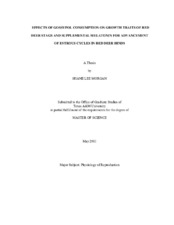| dc.description.abstract | Experiment I studied the effect of dietary gossypol (G) on antler and body growth traits of red deer stags, whereas Experiment II studied the effect of exogenous melatonin on female red deer reproductive traits. Specifically in Experiment I, thirty mature red deer stags were randomly allotted by weight, body condition score, and age to one of three treatment groups (n=10 each): control (C; 5:6 soybean meal:corn), extruded cottonseed pellet (P; 0.04 percent Free G, 0.36 percent Total G) and whole cottonseed-soybean meal (WCS; 5:3 cottonseed:soybean meal, 0.96 percent Free G & Total G). The supplements were mixed to be isocaloric (1661g/d TDN) and isonitrogenous (620-637g CP/d). Stags were fed daily for 155 d from antler casting (2/26/09) until hard antler had been reached (7/31/09). Antlers were measured using the Safari Club International (SCI) scoring method once hard antler was achieved. Hard antlers where removed just above the burr and allowed to dry (60 d) before weighing. Average daily gain did not differ (P > 0.10) among dietary treatment groups. However, average antler weights from C (1.130 plus/minus 0.068 kg) and P (1.297 plus/minus 0.068 kg) were greater (P < 0.04) than WCS (1.041 plus/minus 0.068 kg) weights upon completion of the trial. Although SCI measurements were numerically lowest for WCS, differences were not significant.
In Experiment II, 60 mature and 24 yearling red deer hinds were assigned to two treatments on August 3rd; one received melatonin implants (MEL: n=42), while the other served as a control group (CNTRL: n=42). Hinds were evenly distributed to treatment by lactation status, age and body condition score. Antlerless stags were placed with the hinds (1:14) to provide natural service breeding during the trial. Implants were verified to be functional by a serum melatonin assay. Pregnancy status was determined by ultrasonography on d 105 and verified again on d 150. MEL treatment hinds displayed lower ADG (0.003 plus/minus 0.007 kg/d) than CNTRL (0.020 plus/minus 0.007 kg/d) hinds during the trial (P < 0.01). No advancement of estrous cycles was observed in red deer hinds implanted in early August (P > 0.10); however, pregnancy rates for yearling hinds were increased 36.4 percent (P < 0.04). | en |


